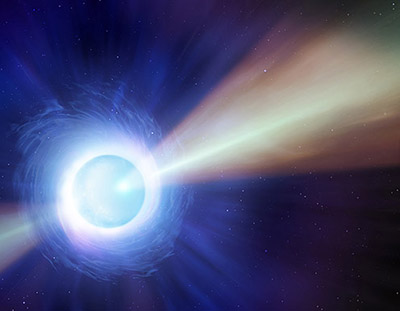Astronomers discover a beam of light from last year’s gravitational wave event
Astronomers discover a beam of light from last year’s gravitational wave event, 100 days after the neutron star merge. The research team had to wait the neutron star merger to re-emerge from behind the glare of the Sun. They were rewarded with the first confirmed visual sighting of a jet of material that was still streaming out from merged star exactly 110 days after that initial cataclysmic merger event was first observed.
Last year, the gravitational wave event from 17 August 2017 made headlines as electromagnetic radiation from an associated kilonova allowed astronomers to pinpoint its location to the galaxy NGC 4993, 130 million light years away. Now, a team of astronomers, led from scientists from the University of Warwick and involving researchers from the University of Copenhagen, have used the Hubble Space Telescope to discover optical emission from the event which does not originate from the kilonova. Instead, the emission is found to stem from interaction between a jet and the interstellar medium surrounding the event, similar to emission seen in short-duration gamma-ray bursts.

The research team had to wait over 100 days for the sight of the first of confirmed neutron star merger to re-emerge from behind the glare of the Sun. They were rewarded with the first confirmed visual sighting of a jet of material that was still streaming out from merged star exactly 110 days after that initial cataclysmic merger event was first observed.
The discovery is published in a paper entitled "The optical afterglow of the short gamma-ray burst associated with GW170817" in Nature Astronomy on 2 July 2018.
The lead author of the team, Dr Joe Lyman from the University of Warwick , said: “Early on, we saw visible light powered by radioactive decay of heavy elements, a hundred days later and this has gone, but now we see a jet of material, ejected at an angle to us, but at almost of the speed of light. This is quite different than some people have suggested, that the material wouldn’t come out in a jet, but in all directions.”
Professor Andrew Levan from the University of Warwick, another of the paper’s leading authors added “If we’d looked straight down this beam we’d have seen a really powerful burst of gamma-rays. This means that it is quite likely that every neutron star that mergers actually creates a gamma-ray burst, but we only since a small fraction of them because the jet doesn’t line up all that often. Gravitational waves are a whole new way to find this kind of event, and they might be more common than we think.”
Professor and VILLUM Investigator Jens Hjorth, from DARK (Niels Bohr Institute, University of Copenhagen) was involved in assessing whether the emission could come from the kilonova. "We quickly realised", he says, "that the kilonova would be too faint at the time of the observation. Instead, we found that emission from an afterglow would be consistent with the observations.”
The exact structure of the jet, or cocoon, is still up for debate. The authors are confident that future observations, more than a year after the event, will allow us to reveal more about the detailed emission mechanism.
Associate Professor Christa Gall from DARK as well as scientists from the new Cosmic DAWN Center (Johan Fynbo, Bo Milvang-Jensen and Darach Watson), were also involved in the new research published today. DARK’s research was funded by the Villum Foundation and the Carlsberg Foundation.
Online: https://www.nature.com/articles/s41550-018-0511-3https://arxiv.org/abs/1801.02669
